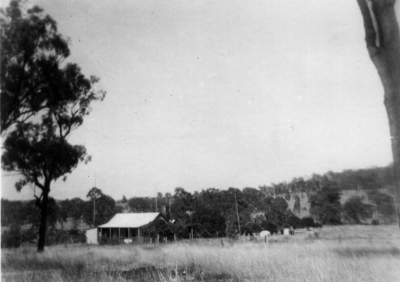Quilt No.327DW - Dulcie Williams
2185 x 1067mm
Made by (Charlotte) Clara Bailey (born Hempel) at 'The Range', Gulegulgul, via Miles, Qld. Owned by her daughter, Dulcie Williams.
Charlotte Clara Bailey trained as a nurse in Toowoomba around 1920. She became a bush nurse at Cecil Plains, and then at Coominya, near Lowood, before she married. Coominya was a soldier settlement township established in 1920. She was the second bush nurse at Coominya, where the nurse's house was occupied by a nurse until 1981.
"The quilt was made on (Charlotte) Clara's treadle sewing machine - Fabric samples were sent up to the property 'The Range' and a selection was made. Clara was a very thorough sewer, making her own clothes, also crocheted, embroidered, knitted �. etc"
" 'The Range' was a cattle property. Dad originally selected a block (the back paddock) and added 'The Range' when he married. In his lifetime he added another block 'Wrights' and one purchased from 'Moores'. He may have had Wrights when he married. 'The Range' was our home and did not join the 'back paddock'. The house was situated at the north east corner of all which made it inconvenient for working the property. However it was on the Miles/Taroom Coach run, the front fence faced the stock route and we could see the train to and from Wandoan as it went by through the neighbouring property. The Miles/Taroom Coach was before my time.
Yes my Mother was an expert needlewoman. She loved hand embroidery and had a lovely trousseaux and made everything on that treadle. Crochet, yes she did all her children and some of the grandchildren a tablecloth, ours was done by kerosene light. She also did tatting. She seldom wore glasses and did her handwork crochet and knitting up until the end. Mother was born 25th May 1894. �
We were isolated in the sense that we were limited to horse & sulky Horse & cart or horses to get about. I was working away from home before we had a car. I can remember riding 11 miles to a neighbours on my own. Some children rode 9 miles to school. To collect mail, meat and bread from Giligulgul and later, Gurulmundi Railway Station Dad would use the horse and cart.
We had a vegetable garden near the dam, this was quite a distance from the house & grew our own vegetables, milked a cow and had a good orchard. � It was near the house & the trees were planted in rows. Navel oranges & mandarins quinces figs a huge mulberry tree. We were always busy doing something making butter etc. After milking the separating had to be done & the churning. The ponies liked the milk sometimes a spare calf sometimes a pig. Mother made her own bread, she preferred potato yeast, later DRIBARM. With all this cooking wood always had to be found.
Mother always made Dad's 'flannels'. She would buy 'Doctors flannel' and make his shirts without a collar. He would add a sweatrag. He always wore braces. He was English & his skin as very fair. He grew corn at the 'back paddock'.
I think the war years added to our thrift but I suppose you could say life was quiet perhaps but never dull. � Our washing was done by boiling the copper & using a clothes stick to get the clothes out into a tub then carry that to the tankstand. No wringer. We preserved eggs in 'Keepeg' or was it 'Kopeg'? And had a barrel in which was the corn meat in brine. I think everyone did these things.
These days a bitumen road miles/Wandoan by passes the old route. My brother (Ernest Gregory) owns the property and has a house more central to his work."
[Letter from Dulcie Williams, 1998.]


Related Quilts:
2070 x 2000mm
2360 x 2310mm
2200 x 1840mm
1750 x 840mm








